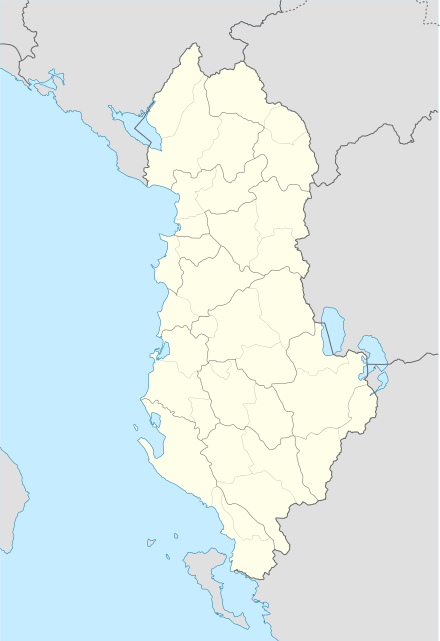Vërnicë
Vërnicë (Bulgarian: Връбница or Върбница, Върмица, Вормица, Macedonian: Врница or Врбница) is a village in the former Trebisht Municipality in Dibër County in northeastern Albania. At the 2015 local government reform it became part of the municipality Bulqizë.[1] It is situated with in the Gollobordë region, near the border with the Republic of Macedonia.
Vërnicë Врница / Врбница | |
|---|---|
 Vërnicë | |
| Coordinates: 41°25′24″N 20°31′38″E | |
| Country | |
| County | Dibër |
| Municipality | Bulqizë |
| Municipal unit | Trebisht |
| Population (2007) | |
| • Total | 548 |
| Time zone | UTC+1 (CET) |
| • Summer (DST) | UTC+2 (CEST) |
History
A demographic survey of the population of the village, done in 1873, recorded the village as having 30 households with 97 male Bulgarian Christian residents.[2]
In 1900, Vasil Kanchov gathered and compiled statistics on demographics in the area and reported that the village of Varbnitsa was inhabited by about 300 Bulgarian Christians.[3] The "La Macédoine et sa Population Chrétienne" survey by Dimitar Mishev (D. Brankov) concluded that the village was inhabited by 256 Bulgarian Exarchists. There was a Bulgarian school in the beginning of 20th century in Varbnitza.[4]
During the Balkan Wars, two men from the village joined the Macedonian-Adrianopolitan Volunteer Corps.[5]
Elez Koçi was killed in the village in 1916 by Bulgarian forces.[6]
In 1939, on behalf of 40 Bulgarian houses in Varbitsa Kuzman Strezov signed a request by the local Bulgarians to the Bulgarian tsaritsa Giovanna requesting her intervention for the protection of the Bulgarian people in Albania - at that time an Italian protectorate.[7]
According to some sources instruction in Macedonian was permitted in Vërnicë during the late 1940s.[8]
Demographics
The village of Vërnicë is inhabited by an Albanian population which dominates demographically in the village.[9] Other inhabitants of Vërnicë are speakers of a south Slavic language[10] (Macedonian) and the village has also traditionally contained a Macedonian Muslim (Torbeš) population.[9]
According to a 2007 estimate, Vërnicë's population was 548.[11]
References
- "Law nr. 115/2014" (PDF). Archived from the original (PDF) on 2015-09-24. Retrieved 2017-02-25.
- „Македония и Одринско. Статистика на населението от 1873 г.“ Македонски научен институт, София, 1995, стр.172-173.
- Vasil Kanchov (1900). Кънчов, Васил. Македония. Етнография и статистика, София, 1900, с. 261. (Macedonia: Ethnography and Statistics, p. 261. Accessed 09 April 2018 (in Bulgarian)
- D.M.Brancoff. "La Macédoine et sa Population Chrétienne". Paris, 1905, pp. 152-153. Accessed 09 April 2018 (in French)
- „Македоно-одринското опълчение 1912-1913 г. Личен състав“, Главно управление на архивите, 2006, стр.589.
- Sinani, Rakip: Dibra dhe dibranët në faqen e historisë ISBN 99943-625-8-5
- Елдъров, Св. Българите в Албания 1913-1939. Изследване и документи, София, 2000, с. 324-326.
- "Вистината за Македонското Училиште во Врница, Голо Брдо" (in Macedonian). Makedonium. 27 January 2013. Retrieved 23 July 2014.
- Vidoeski, Božidar (1998). Dijalektite na makedonskiot jazik. Vol. 1. Makedonska akademija na naukite i umetnostite. ISBN 9789989649509.CS1 maint: ref=harv (link) p. 309. "Во западна Македонија исламизирано македонско население живее во неколку географски региони на македонско-албанската пограничје: во областа Река по долината на Радика (Жировница, Видуше, Болетин, Требиште, Велебрдо, Ростуша, Аџиевци, Јанче, Присојница, Скудриње, Горно и Долно Косоврасти, Могорче, Баланци, Мелничани), во Дебарско - во Жупа (Броштица, Бајрамовци, Горенци, Житинени, Кочишта, Мал и Голем Папрадник, Рковци) и Голо Брдо (Врмница, Владимирци, Гиновци, Клење, Лешничани, Љуболези, Големо и Мало Острени, Окштун, Отишани,"; p 339. "Во повеќето од спомнативе села живее население - со македонски и со албански мачин јазик. Албанското население доминира во северните голобрдски села Себишта, Пасинки, Врмница, Големо и Мало Острени). Селата: Лешничани, Требиште, Српетово, Торбач, Љуболези, Владимирица и Тучепи се населени со Македонски муслимани (Торбеши), а во Себишта, Требиште, Г. и М. Острени живее мешано население - православни и Торбеши."
- Steinke, Klaus; Ylli, Xhelal (2008). Die slavischen Minderheiten in Albanien (SMA): Golloborda - Herbel - Kërçishti i Epërm. Teil 2. Munich: Verlag Otto Sagner. p. 10. ISBN 9783866880351.CS1 maint: ref=harv (link) "Heute umfaßt das Gebiet von Golloborda in Albanien 22 Dörfer, die verwaltungstechnisch auf drei verschiedene Gemeinden aufgeteilt sind: 1. Die Gemeinde Ostren besteht aus dreizehn Dörfern, und Südslavisch wird in den folgenden neun Dörfern gesprochen: Ostreni i Madh (Golemo Ostreni/Ostreni Golemo), Kojavec (Kojovci), Lejçan (Lešničani), Lladomerica (Ladomerica/Ladimerica/Vlademerica), Ostreni i Vogël (Malo Ostreni/Malastreni/Ostreni Malo), Orzhanova (Oržanova), Radovesh (Radoveš/Radoeš/Radoešt), Tuçep (Tučepi) und Pasinka (Pasinki). 2. Die Gemeinde von Trebisht umfaßt die vier Dörfer Trebisht (Trebišta), Gjinovec (G'inovec/G'inec), Klenja (Klen'e) und Vërnica (Vărnica), und in allen wird Südslavisch gesprochen. 3. Die übrigen Dörfer von Golloborda gehören zur Gemeinde Stebleva, und zwar Stebleva, Zabzun, Borova, Sebisht, Llanga. Südslavisch wird in Stebleva (Steblo) sowie von drei Familien in Sebisht (Sebišta) gesprochen. Wie aus den bisherigen Ausführungen und den Erhebungen vor Ort hervorgeht, gibt es nur noch in fünfzehn der insgesamt Dörfer, die heute zu Golloborda gehören, slavophone Einwohner. Die Zahl der Dörfer in Golloborda wird manchmal auch mit 24 angegeben. Dann zählt man die Viertel des Dorfes Trebisht, und zwar Trebisht-Bala, Trebisht-Çelebia und Trebisht-Muçina separat."
- "Strategic Development Plan of Trebisht Commune" (PDF). p. 4. Retrieved 23 July 2014.
